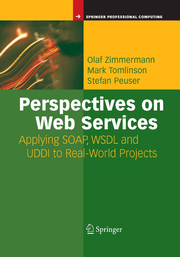Detailansicht
Perspectives on Web Services
Applying SOAP, WSDL and UDDI to Real-World Projects, Springer Professional Computing
ISBN/EAN: 9783540009146
Umbreit-Nr.: 690505
Sprache:
Englisch
Umfang: XXXII, 648 S.
Format in cm: 4 x 24.1 x 18
Einband:
gebundenes Buch
Erschienen am 25.07.2005
Auflage: 2/2005
- Kurztext
- With a Foreword by Grady Booch
- Schlagzeile
- Inhaltsangabe1 The Business Perspective.- 1.1 The Sponsor's View. and a Few Other Opinions l.- 1.2 Web Services - Holy Grail or Déjà Vu?.- l.2.1 Business Drivers and Benefits.- l.2.2 Requirements for Application-to-Application Communication.- l.2.3 Additional Advantages.- l.2.4 Litmus Test (a.k.a. Applicability Filter).- 1.3 Usage Scenarios.- 1.3.1 Enterprise Application Integration (EAI).- 1.3.2 Business-to-Business (B2B).- 1.3.3 Common Services.- 1.3.4 Miscellaneous Scenarios.- 1.4 Potential Inhibitors.- 1.4.1 Over-Enthusiastic Expectations.- 1.4.2 Goal Conflicts.- 1.4.3 Skepticism about New Technology.- 1.4.4 Security and Performance Concerns.- 1.4.5 Logistical and Organizational Issues.- 1.4.6 Skill Deficiencies.- 1.4.7 Roll-Your-Own (RYO) Temptation.- 1.4.8 So Do the Inhibitors Really Inhibit Us?.- 1.5 Introduction to the Case Study.- 1.5.1 Background Information.- 1.5.2 The Business Problem.- 1.5.3 Solution Outline.- 1.6 Summary.- 1.6.1 Key Messages.- 1.6.2 Where to Find More Information.- 1.6.3 What's Next.- 2 The Training Perspective.- 2.1 The Trainer's View. And What the Trainees Think.- 2.2 Web Services Concepts in a Nutshell.- 2.2.1 Roles and Relationships.- 2.2.2 A First Look at the Case Study Solution.- 2.2.3 Where to Go from Here.- 2.3 XML, XML Namespaces and XML Schema.- 2.3.1 An XML Overview.- 2.3.2 XML Namespaces.- 2.3.3 XML Schema.- 2.3.4 Summary and Next Steps.- 2.4 Understanding SOAP.- 2.4.1 The SOAP Message Format.- 2.4.2 The SOAP Section 5 Encoding.- 2.4.3 SOAP Communication Styles.- 2.4.4 Summary and Next Steps.- 2.5 Understanding WSDL.- 2.5.1 The WSDL Building Blocks.- 2.5.2 The Containment Structure of a WSDL Document.- 2.5.3 The Logical Relationships between WSDL Elements.- 2.5.4 The SOAP Binding.- 2.5.5 Summary and Next Steps.- 2.6 Understanding UDDI.- 2.6.1 The UDDI Registry Structure.- 2.6.2 Linking WSDL Documents to a UDDI Registry.- 2.6.3 A Brief UDDI API Overview.- 2.6.4 Private versus Public UDDI Registries.- 2.6.5 Summary.- 2.7 Summary.- 2.7.1 Key Messages.- 2.7.2 Where to Find More Information.- 2.7.3 What's Next.- 3 The Architecture Perspective.- 3.1 The Architect's View.- 3.2 Introduction to Web Services Architectures.- 3.2.1 Motivation.- 3.2.2 Introduction to the W3C Web Services Architecture.- 3.2.3 Service-Oriented Architecture and Java.- 3.3 Web Services Principles and Patterns.- 3.3.1 General Architectural Principles and Design Patterns.- 3.3.2 Business Patterns.- 3.3.3 Architectural Patterns.- 3.4 Architectural Decisions.- 3.4.1 Service Modeling: WSDL and XML Schema.- 3.4.2 Service Messaging: SOAP.- 3.4.3 Service Matchmaking: UDDI and WSIL.- 3.4.4 General Decisions.- 3.4.5 Software Architecture for the Case Study.- 3.5 Non-Functional Requirements (NFRs).- 3.5.1 Performance.- 3.5.2 Scalability.- 3.5.3 Availability.- 3.5.4 Robustness.- 3.5.5 Portability.- 3.6 Gaps and Countermeasures.- 3.6.1 The XML Language Binding and Encoding Maze.- 3.6.2 Security.- 3.6.3 Web Service Management.- 3.6.4 Transactional and Context Semantics.- 3.6.5 Process Orchestration and Workflow.- 3.7 Frequently Asked Questions.- 3.8 Summary.- 3.8.1 Key Messages.- 3.8.2 Where to Find More Information.- 3.8.3 What's Next.- 4 The Development Perspective.- 4.1 A Developer's View.- 4.2 Introduction to Developing Web Services in Java.- 4.2.1 IBM Development Tools Supporting Web Services.- 4.2.2 Getting Started with Eclipse and WebSphere Studio.- 4.2.3 Selecting a Web Services Implementation.- 4.2.4 Conclusions.- 4.3 Preparing the Sample Application.- 4.3.1 Background to the Sample.- 4.3.2 Current Implementations.- 4.3.3 Constructing the New Applications.- 4.3.4 Configuring the Sample Application.- 4.3.5 Summary.- 4.4 Building rpc/encoded Services from Java.- 4.4.1 Introduction.- 4.4.2 Building EJB Web Services with Apache SOAP.- 4.4.3 Building EJB Web Services with JAX-RPC and JSR 109.- 4.4.4 Conclusions.- 4.5 Building Web Service Clients.- 4.5.1 Introduction.- 4.5.2 Web Service Clients using Apache SOAP.- 4.5.3 Web Service Clien
